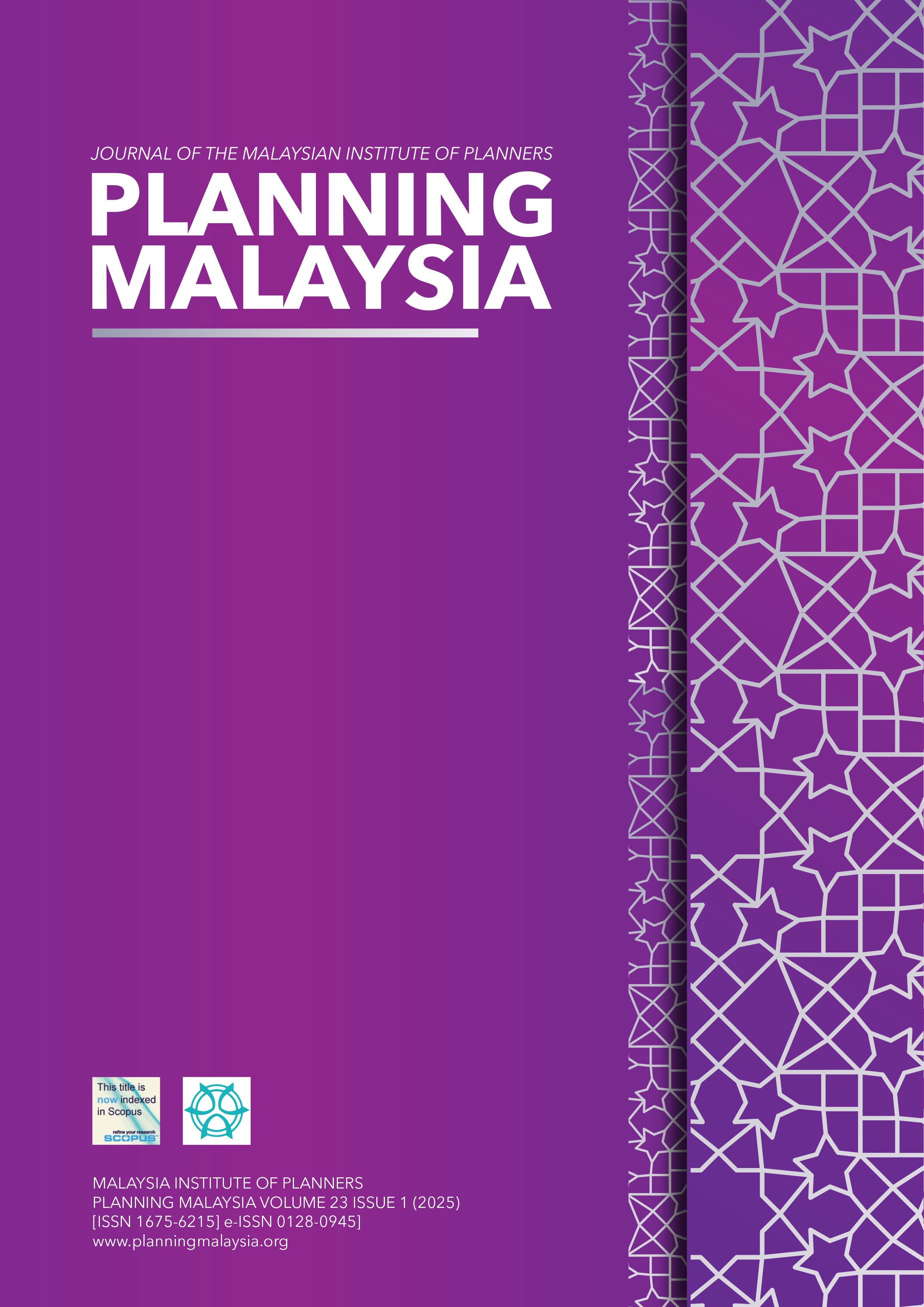COMMUNITY, CULTURE AND CONSERVATION: MAPPING THE BIOCULTURAL LANDSCAPE RESOURCES OF SUNGAI TEMBUS, SEBERANG PERAI FOR TOURISM
DOI:
https://doi.org/10.21837/pm.v23i35.1678Keywords:
Bio-cultural, community, landscape, tourismAbstract
Integrating biocultural resources into tourism development is vital to promote sustainable practices that benefit the local community and the environment. Biocultural landscape resources include biodiversity and cultural heritage, where natural and cultural attributes are interconnected and can affect the sustainability of one another. Hence, examining biocultural resources as a connected network between nature and culture is integral. This paper investigates the biocultural landscape resources of Sungai Tembus, Seberang Perai, as unique opportunities to leverage the ecological features of the area and the local cultural practices. Through a mixed-method approach, the study gathered on-ground data through semi-structured interviews with local community members to gather their insights and experiences, which were complemented by mapping the resources using Geographic Information System (GIS) and photographic documentation. The result of the study shows that the local community's livelihood and tourism activities depend on biocultural resources. The findings reveal that the cultural heritage is shaped by the ecological features, highlighting the importance of community engagement in conservation efforts and tourism planning.
Downloads
References
mangrove saplings planted along Sg Tembus. (2024, June 5). The Star.
Amo-Rodríguez, S. Del, Vergara-Tenorio, C. Del, Ramos-Prado, J. M., & Porter-Bolland, L. (2010). Community landscape planning for rural areas: A model for biocultural resource management. Society and Natural Resources, 23(5). https://doi.org/10.1080/08941920802537781 DOI: https://doi.org/10.1080/08941920802537781
Brooks, J. S., Waylen, K. A., & Mulder, M. B. (2012). How national context, project design, and local community characteristics influence success in community-based conservation projects. Proceedings of the National Academy of Sciences of the United States of America, 109(52). https://doi.org/10.1073/pnas.1207141110 DOI: https://doi.org/10.1073/pnas.1207141110
David Cooper, H., & Noonan-Mooney, K. (2013). Convention on Biological Diversity. In Encyclopedia of Biodiversity: Second Edition. https://doi.org/10.1016/B978-0-12-384719-5.00418-4 DOI: https://doi.org/10.1016/B978-0-12-384719-5.00418-4
Elyasi, S., & Yamacli, R. (2023). Architectural sustainability with cultural heritage values. Cultural Heritage and Science, 4(2). https://doi.org/10.58598/cuhes.1282179 DOI: https://doi.org/10.58598/cuhes.1282179
Gavin, M. C., McCarter, J., Mead, A., Berkes, F., Stepp, J. R., Peterson, D., & Tang, R. (2015). Defining biocultural approaches to conservation. In Trends in Ecology and Evolution (Vol. 30, Issue 3). https://doi.org/10.1016/j.tree.2014.12.005 DOI: https://doi.org/10.1016/j.tree.2014.12.005
Ghayoumi, R., Charles, A., & Mousavi, S. M. (2023). A multi-level analysis of links between government institutions and community-based conservation: Insights from iran. Ecology and Society, 28(2). https://doi.org/10.5751/ES-14217-280233 DOI: https://doi.org/10.5751/ES-14217-280233
Kaulen-Luks, S., Marchant, C., Olivares, F., & Ibarra, J. T. (2022). Biocultural heritage construction and community-based tourism in an important indigenous agricultural heritage system of the southern Andes. International Journal of Heritage Studies, 28(10). https://doi.org/10.1080/13527258.2022.2131882 DOI: https://doi.org/10.1080/13527258.2022.2131882
La Rosa, A., Cornara, L., Saitta, A., Salam, A. M., Grammatico, S., Caputo, M., La Mantia, T., & Quave, C. L. (2021). Ethnobotany of the Aegadian Islands: safeguarding biocultural refugia in the Mediterranean. Journal of Ethnobiology and Ethnomedicine, 17(1). https://doi.org/10.1186/s13002-021-00470-z DOI: https://doi.org/10.1186/s13002-021-00470-z
Luković, M., Pantović, D., Riznić, D., Lakićević, M., & Milutinović, S. (2022). Place of Biocultural Heritage in Post Covid-19 Tourism Destination Choice. Ecologica, 29(107). https://doi.org/10.18485/ecologica.2022.29.107.16 DOI: https://doi.org/10.18485/ecologica.2022.29.107.16
Maffi, L., & Woodley, E. (2012). Biocultural Diversity Conservation. In Biocultural Diversity Conservation. https://doi.org/10.4324/9781849774697 DOI: https://doi.org/10.4324/9781849774697
Muhumuza, M., & Balkwill, K. (2013). Factors Affecting the Success of Conserving Biodiversity in National Parks: A Review of Case Studies from Africa. International Journal of Biodiversity, 2013. https://doi.org/10.1155/2013/798101 DOI: https://doi.org/10.1155/2013/798101
Nemogá, G. R. (2016). Biocultural diversity: Innovating in research for conservation. Acta Biologica Colombiana, 21(1). DOI: https://doi.org/10.15446/abc.v21n1Supl.50920
Newing, H., Fisher, M., Brittain, S., Kenrick, J., & Milner-Gulland, E. J. (2023). How can we advance equitable, rights-based conservation? In ORYX (Vol. 57, Issue 3). https://doi.org/10.1017/S0030605323000418 DOI: https://doi.org/10.1017/S0030605323000418
O’Neill, A. R., Badola, H. K., Dhyani, P. P., & Rana, S. K. (2017). Integrating ethnobiological knowledge into biodiversity conservation in the Eastern Himalayas. In Journal of Ethnobiology and Ethnomedicine (Vol. 13, Issue 1). https://doi.org/10.1186/s13002-017-0148-9 DOI: https://doi.org/10.1186/s13002-017-0148-9
Penang gazettes eight mangrove forests as permanent reserved forests. (2023, January 5). Buletin Mutiara.
Reyes-Garcia, V., Ruiz-Mallen, I., Porter-Bolland, L., Garcia-Frapolli, E., Ellis, E. A., Mendez, M. E., Pritchard, D. J., & Sanchez-Gonzalez, M. C. (2013). Local understandings of conservation in southeastern mexico and their implications for community-based conservation as an alternative paradigm. Conservation Biology, 27(4). https://doi.org/10.1111/cobi.12056 DOI: https://doi.org/10.1111/cobi.12056
Robinson, L. W., & Makupa, E. (2015). Using Analysis of Governance to Unpack Community-Based Conservation: A Case Study from Tanzania. Environmental Management, 56(5). https://doi.org/10.1007/s00267-015-0573-2 DOI: https://doi.org/10.1007/s00267-015-0573-2
Ruiz-Mallén, I., & Corbera, E. (2013). Community-based conservation and traditional ecological knowledge: Implications for social-ecological resilience. Ecology and Society, 18(4). https://doi.org/10.5751/ES-05867-180412 DOI: https://doi.org/10.5751/ES-05867-180412
Salerno, J., Romulo, C., Galvin, K. A., Brooks, J., Mupeta-Muyamwa, P., & Glew, L. (2021). Adaptation and evolution of institutions and governance in community-based conservation. Conservation Science and Practice, 3(1). https://doi.org/10.1111/csp2.355 DOI: https://doi.org/10.1111/csp2.355
Sani, J. A., Sharip, N. A. A., & Ibrahim, P. H. (2020). Soft-scape quality issues in landscape construction industry: Malaysia. Alam Cipta, 13(1).
Sudiasmo, F., & Muspita, N. C. (2020). Local wisdom in environment conservation: A study on a conservation and energy self-sufficient village. Masyarakat, Kebudayaan Dan Politik, 33(4). https://doi.org/10.20473/mkp.v33i42020.405-412 DOI: https://doi.org/10.20473/mkp.V33I42020.405-412
Teressa, H. (2022). Conservation challenges of Afroalpine and Subafroalpine ecosystems in Mount Guna: A new community-based conservation area, Ethiopia. African Journal of Ecology, 60(3). https://doi.org/10.1111/aje.12980 DOI: https://doi.org/10.1111/aje.12980
Downloads
Published
How to Cite
Issue
Section
License

This work is licensed under a Creative Commons Attribution-NonCommercial-NoDerivatives 3.0 Unported License.
Copyright & Creative Commons Licence
eISSN: 0128-0945 © Year. The Authors. Published for Malaysia Institute of Planners. This is an open-access article under the CC BY-NC-ND license.
The authors hold the copyright without restrictions and also retain publishing rights without restrictions.


